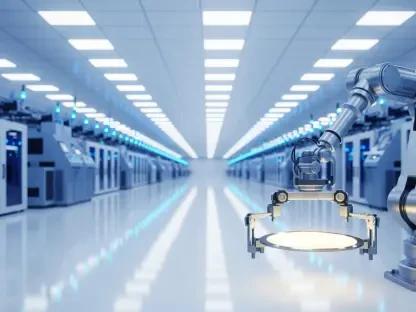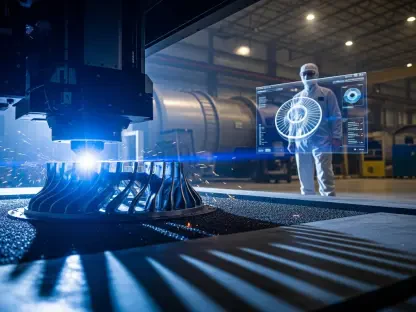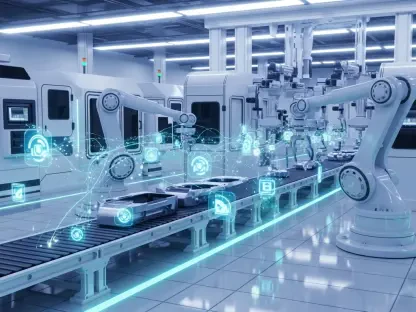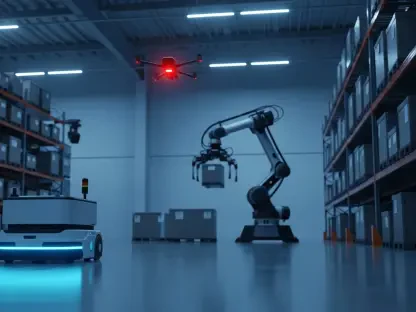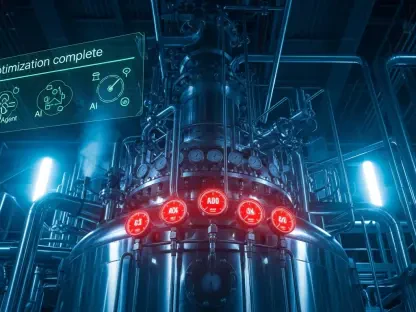In the heart of a bustling factory, where machines hum with precision and data flows seamlessly across interconnected systems, a single phishing email can bring operations to a grinding halt, illustrating the critical need for robust cybersecurity. This scenario is not a distant threat but a stark reality for manufacturers in the era of Industry 4.0, where digitization has transformed production but also exposed critical vulnerabilities. Cyberattacks, such as ransomware, can disrupt supply chains, halt production lines, and cost millions in damages, making cybersecurity a cornerstone of modern manufacturing. The importance of adopting robust best practices cannot be overstated, as the stakes involve not just technical integrity but also business survival. This guide delves into actionable strategies to build cyber resilience, ensuring factories remain secure amidst evolving digital threats.
The Rising Importance of Cybersecurity in Manufacturing
The advent of Industry 4.0 has ushered in an era of unprecedented connectivity, with factories relying on integrated IT and operational technology (OT) systems to drive efficiency. However, this digitization has expanded the attack surface, making manufacturers prime targets for cybercriminals seeking to exploit vulnerabilities. Ransomware, system intrusions, and data breaches are no longer isolated incidents but pervasive risks that can cripple operations in mere hours. What was once considered a niche technical concern has evolved into a strategic business priority, demanding attention from every level of an organization.
This shift in perspective stems from the tangible impacts of cyber incidents, which extend beyond mere data loss to include production downtime, supply chain disruptions, and eroded customer trust. Manufacturers must recognize that safeguarding digital assets is as critical as maintaining physical equipment. The focus of this guide is to explore the specific vulnerabilities facing factories, highlight the real-world consequences of inaction, and provide a roadmap of best practices to fortify defenses in this interconnected landscape.
Why Cyber Resilience is a Business Necessity
Cyber incidents pose a profound threat to manufacturing businesses, often resulting in extensive downtime that halts production and delays deliveries. Financial losses from such disruptions are staggering, with IBM’s latest report indicating an average cost of $5.56 million per industrial breach. Beyond immediate monetary damage, the reputational harm can deter investors and alienate customers, creating long-term challenges for recovery.
Investing in robust cybersecurity measures offers significant advantages, starting with operational continuity that keeps factories running even under threat. Protecting intellectual property, such as proprietary designs and processes, is another key benefit, safeguarding a company’s competitive edge. Additionally, proactive defenses lead to cost savings by preventing breaches, while maintaining trust among stakeholders reinforces market confidence. These outcomes highlight why cyber resilience is not an option but an essential component of business strategy.
The urgency of these measures is underscored by the scale of potential losses and the increasing sophistication of cyber threats. Manufacturers that prioritize resilience position themselves to mitigate risks effectively, ensuring they can withstand attacks without sacrificing growth or stability. Embracing cybersecurity as a core business function is the foundation for thriving in a digital-first industrial environment.
Key Strategies for Building Cyber Resilience in Factories
Implementing Continuous Monitoring and Threat Intelligence
In a factory where every second of uptime counts, real-time monitoring of both IT and OT systems is indispensable for detecting anomalies before they escalate into full-blown crises. Continuous oversight allows for swift identification of suspicious activities, such as unauthorized access attempts or unusual data transfers, enabling rapid response to neutralize threats. This proactive approach minimizes the window of opportunity for attackers to exploit vulnerabilities.
To implement effective monitoring, manufacturers should deploy advanced tools like Extended Detection and Response (XDR) platforms, which integrate data from multiple sources for comprehensive visibility. Complementing this with threat intelligence services helps anticipate emerging risks by providing insights into the latest attack vectors and adversary tactics. Regular updates to these systems ensure they remain aligned with the evolving threat landscape, keeping defenses sharp.
Case Study: Early Threat Detection in Action
A notable example of monitoring’s impact involved a mid-sized manufacturer that detected a phishing attempt targeting its payroll system through real-time alerts. By identifying the malicious email before any credentials were compromised, the company’s security team isolated the affected endpoint, preventing a potential ransomware deployment. This swift action preserved production schedules and avoided significant financial loss, demonstrating the value of vigilant oversight in maintaining operational integrity.
Strengthening Defenses with Network Segmentation and Access Controls
Isolating critical systems through network segmentation is a vital strategy to limit the spread of cyberattacks within a factory’s infrastructure. By creating distinct zones for IT and OT environments, manufacturers can ensure that a breach in one area does not cascade across the entire network. This containment approach reduces the risk of widespread disruption, protecting core operations from collateral damage.
Implementing strict access controls further fortifies defenses by restricting system entry to authorized personnel only. Multi-factor authentication (MFA) should be mandatory for all users, adding an extra layer of verification to prevent unauthorized access even if credentials are stolen. Regularly reviewing and updating access privileges ensures that former employees or contractors cannot exploit lingering permissions, maintaining a tight security perimeter.
Example: Preventing Lateral Movement in a Cyberattack
Consider a scenario where a ransomware attack infiltrated a factory’s IT network through a compromised vendor account. Thanks to pre-established network segmentation, the malware was confined to non-critical systems, unable to reach the OT environment controlling production lines. This containment limited the damage to a small segment of operations, allowing the manufacturer to remediate the issue without a full shutdown, showcasing the effectiveness of strategic isolation.
Prioritizing Vulnerability Management and Legacy System Updates
Outdated OT systems, often designed to operate for decades, pose significant risks in modern factories due to unsupported software and obsolete security protocols. These legacy setups are prime targets for attackers who exploit known vulnerabilities that can no longer be patched. Addressing this challenge requires a commitment to regular system assessments to identify and prioritize weaknesses for remediation.
Practical steps include automating patch management to ensure timely updates across all compatible systems, reducing manual oversight burdens. For equipment too old to support updates, manufacturers should plan strategic replacements, even if initial costs seem prohibitive. Budgeting for phased upgrades over a defined period, such as from this year to 2027, can distribute expenses while progressively shrinking the attack surface.
Real-World Impact: Upgrading to Mitigate Risks
A compelling instance of modernization’s benefits emerged when a steel manufacturer replaced its decades-old control systems after repeated intrusion attempts exploited unpatchable flaws. By investing in updated technology with built-in security features, the company not only eliminated persistent threats but also improved operational efficiency. This case illustrates how the long-term gains of modernization far outweigh the upfront investment, securing both data and productivity.
Moving Forward: Strategic Insights for Cyber Resilience
Elevating cybersecurity to a board-level priority marks a crucial cultural shift for manufacturers aiming to thrive in Industry 4.0. Leadership involvement ensures that cyber resilience is woven into business planning, aligning security investments with organizational goals. This strategic integration fosters a mindset where every employee, from executives to floor operators, recognizes their role in safeguarding digital assets.
For small and medium-sized businesses (SMBs) with constrained resources, adopting scalable solutions like Managed Detection and Response (MDR) services offers a practical path forward. These tools provide enterprise-grade protection without the need for expansive in-house teams, leveling the playing field against sophisticated threats. Evaluating cybersecurity expenditures through a risk-based lens helps SMBs balance cost with exposure, focusing resources on the most critical areas.
Guidance on assessing investments involves defining an acceptable risk threshold tailored to specific factory needs, ensuring defenses match operational priorities. Collaborating with industry peers to share threat insights can also enhance preparedness without straining budgets. By embedding these strategies into long-term planning, manufacturers lay the groundwork for enduring resilience in an increasingly digital industrial landscape.
Final Reflections
Looking back, this exploration of cyber resilience underscored the profound vulnerabilities that have threatened factories amidst the rapid digitization of Industry 4.0. Each strategy discussed, from continuous monitoring to legacy system upgrades, provided a vital piece of the puzzle in fortifying manufacturing environments against relentless cyber threats. The real-world examples have vividly illustrated how proactive measures thwarted potential disasters, preserving both operations and reputation.
As a next step, manufacturers should conduct a comprehensive audit of their current cybersecurity posture to identify gaps and prioritize interventions. Partnering with trusted security vendors to implement tailored solutions can accelerate this process, ensuring robust protection without overwhelming internal teams. Embracing a forward-thinking approach by regularly revisiting and refining defenses will position factories to adapt to emerging risks, securing their place as leaders in a connected industrial future.


